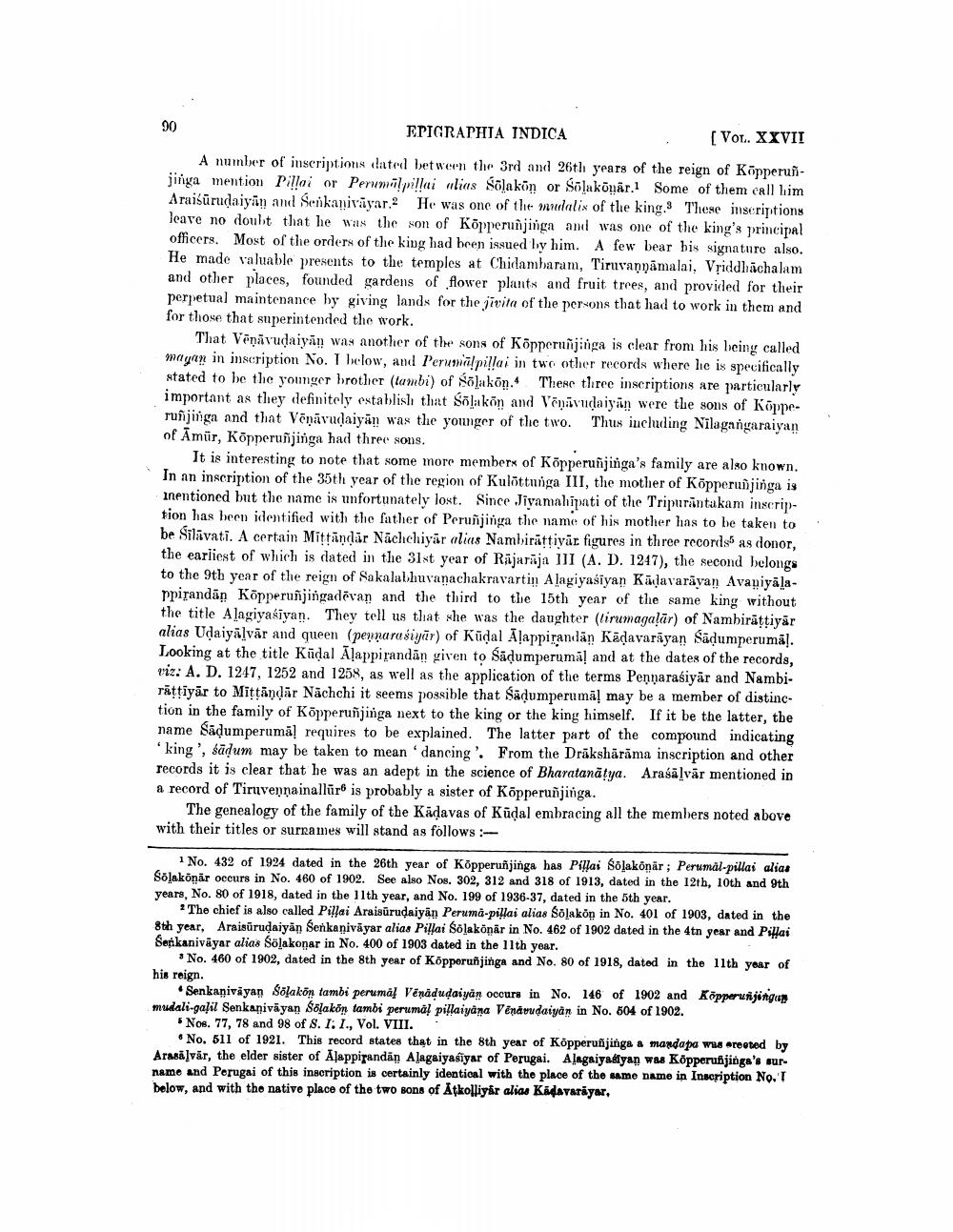________________
EPIGRAPHIA INDICA
. [Vol. XXVII A number of inscriptions dated between the 3rd and 26th years of the reign of Köpperunjinga mention Pillai or Perumalpillai wias Sõlakon or Solakūnar. Some of them call lim Araisūrudaiyan and Senkanivayar. He was one of the mulalix of the king. These inscriptions leave no doubt that he was the son of Köpperunjinga and was one of the king's principal officers. Most of the orders of the king had been issued ly him. A few bear bis signature also. He made valuable presents to the temples at Chidambaram, Tiruvannamalai, Vriddhachalam and other places, founded gardens of flower plants and fruit trees, and provided for their perpetual maintenance by giving lands for the jivita of the persons that had to work in them and for those that superintended the work.
That Vēnāvudaiyān was another of the sons of Körperusjinga is clear from his being called mayron in inscription No. I below, and Perumalpillai in two other records where he is specifically stated to be the younger brother (tambi) of Sõlakon. These three inscriptions are particularly important as they definitely establish that Sõlakon and Vēnāvudaiyan were the sons of Kõpperuninga and that Vēnāvudaiyan was the younger of the two. Thus including Nilagangaraiyan of Āmür, KÕpperuñjinga had three sons.
It is interesting to note that some more members of Körperuñjinga's family are also known. In an inscription of the 35th year of the region of Kulõttunga III, the mother of Kõpperunjinga is Inentioned but the name is unfortunately lost. Since Jivamahipati of the Tripurantakam inscription has been identified with the father of Peruñjinga the name of his mother has to be taken to be Silivati. A certain Mittandür Nachchiyar alias Nambirättivär figures in three records as donor, the earliest of which is dated in the 31st year of Rajaraja l]I (A. D. 1247), the second belongs to the 9th year of the reign of Sakalabhuvanachakravartin Alagiyasiyan Kālavarayan Avaniyāļapriyandan Kõpperunjingadēvan and the third to the 15th year of the same king without the title Alagiyasiyan. They tell us that she was the daughter (lirumagalär) of Nambirättiyar alias Udaiyālvār and queen (pennarasiyūr) of Kūdal Alappirandān Kādavarāyan Sadumperumal. Looking at the title Kūdal Alappirandan given to Sadumperumā! and at the dates of the records, viz: A. D. 1247, 1252 and 1258, as well as the application of the terms Pennarasiyār and Nambi. rättiyar to Mittandar Nächchi it seems possible that Sadumperumāļ may be a member of distinction in the family of Köpperuñjinga next to the king or the king himself. If it be the latter, the name Sädumperumal requires to be explained. The latter part of the compound indicating 'king', šādum may be taken to mean 'dancing'. From the Drākshārāma inscription and other records it is clear that he was an adept in the science of Bharatanatya. Arasalvār mentioned in a record of Tiruveynainallūro is probably a sister of Köpperuñjinga.
The genealogy of the family of the Kädavas of Kudal embracing all the members noted above with their titles or surnames will stand as follows:
1 No. 432 of 1924 dated in the 26th year of KÕpperuñjinga has Pilai Solakõnar; Perumal-pillai alias Soļakonär occurs in No. 460 of 1902. See also Nos. 302, 312 and 318 of 1913, dated in the 12th, 10th and 9th years, No. 80 of 1918, dated in the 11th year, and No. 199 of 1936-37, dated in the 5th year.
The chief is also called Pillai Araisūrudaiyan Peruma-pillai alias Soļakon in No. 401 of 1903, dated in the 8th year. Araisūrudaiyan Senkaniváyar alias Pillai Sólakönär in No. 462 of 1902 dated in the 4tn year and Piffai Serkanivayar alias Slakonar in No. 400 of 1903 dated in the 11th year.
* No. 460 of 1902, dated in the 8th year of Köpperuñjinga and No. 80 of 1918, dated in the 11th year of his reign.
Senkanivayan Solakón tambi peruma! Vērādudaiyan occurs in No. 146 of 1902 and Kõpperunjungan mwali-galil Senkanivayan Solakön tambi perumal pillaiyana Vendeudaiyan in No. 504 of 1902.
Nos. 77, 78 and 98 of 8. 1. 1., Vol. VIII.
• No. 511 of 1921. This record states that in the 8th year of Kopperufijinga a mandapo was erected by Arasä]văr, the elder sister of Alappirandan Alagaiyasīyar of Perugai. Alagaiyaayan was Kopperupjioga's sur name and Perugai of this inscription is certainly identical with the place of the same namo in Inscription No. 'I below, and with the native place of the two sons of Åtkolliyar alias Kidavariyar,




